#masticha
Text
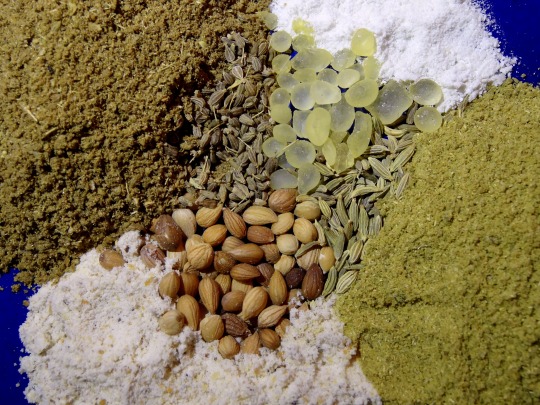
[ID: Mahlab seeds, aniseed, fennel seeds, and mastic in the center of a plate, surrounded by piles of the same spices in powdered form. End ID]
دقة كعك فلسطينية / Dugga ka'k falastinia (Palestinian spice blend for cakes)
دُقَّة كَعْك ("dugga ka'k"; "cake powder")—also known as "بَهَار الكَعْك" ("bahār al-ka'k"; "cake spice") or "بَهَارَات الكَعْك" ("bahārāt al-ka'k"; "cake spices")—is a blend of spices used in Palestinian cakes and sweet pastries. Even when a recipe doesn't call for the blend explicitly, you'll often spot its components in the ingredients list: aniseed, fennel, mahlab, and mastic.
"دُقَّة" is a noun meaning "fine powder." It comes from the verb "دَقَّ" ("daqqa": Levantine pronunciation, "dagga" or "da'a"), meaning "to crush," "to grind," or "to powder." The verb is of the root pattern "د ق ق" (d q q), which produces words related to accuracy and precision (and thus, to small measures of things): compare "دِقّة" ("diqqa") "accuracy"; "دَقِيقَة" ("daqīqa") "minute" (the measure of time); and "دَقِيق" ("daqīq"), which means both "accurate" and "flour, meal."
"كَعْك" refers to pastries including cookies, tarts, buns, and cakes; it is related to the Aramaic "כַּעְכָּא" ("ka'kā") "cake."
This spice blend is used for pastries including مَعْمُول ("ma'mūl")—date-filled semolina cookies—and فَتُوت ("fatūt"), a soft, sweet flatbread from Nablus. The sweet, liquorice-like fennel and aniseed, the mahlab's notes of fruit and almond, and the mastic's smell of cedar and citrus combine to make a delicately aromatic blend that gives an incredible depth of scent and flavor when small amounts are added in with flour.
Recipe under the cut!
Ingredients:
2 Tbsp (11g) aniseed (يانسون)
2 Tbsp fennel seeds (شمره / شومر)
2 tsp (7g) mahlab seeds (محلب) (or 2 tsp mahlab powder, packed)
1/4 tsp (.8g) mastic granules (مستكة)
Pinch of granulated sugar
Pinch of grated nutmeg (optional)
Aniseed, fennel, and mahlab are essential to this blend. Mastic is usually included. Small amounts of nutmeg and cinnamon are also possible additions. Some people also include a very small amount of a commercial "ريحة الكعك" ("riha al-ka'k" "cake scent”)—also known as "كلفة كعك" ("kulfa al-ka'k")—which might contain sweet spices such as cinnamon, cloves, cardamom, and allspice, as well as camphor (كَافُور), Arab yeast (خميرة العرب), bay laurel leaves, and rose hips (ذر الورد), depending on where it is sourced.
The word "يانسون" ("yansoun") can be used to refer to aniseed or to star anise (or to a beverage brewed with aniseed); in this context, it invariably refers to aniseed. Aniseed is an oval-shaped seed—smelling of liquorice, and looking a bit like cumin, fennel, or caraway, but much smaller—with a body that tapers in towards the stem end. It can be found at a halal grocery store.
Mahlab seeds may be found at a halal grocery store, though you are more likely to find it in pre-ground form. The whole seeds may also be purchased online. Mahlab should be purchased in small quantities and kept in the refrigerator or even the freezer, as it will go rancid after several months at room temperature.
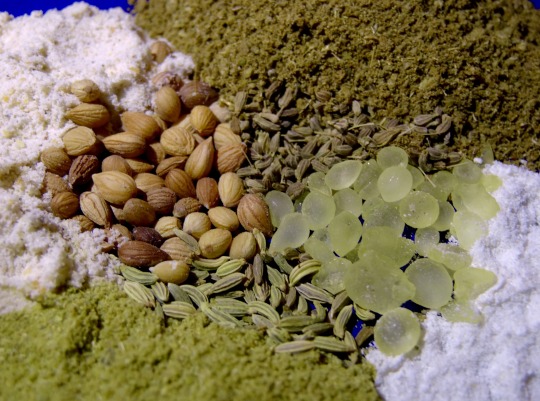
Mahlab seeds (left); aniseed (top); fennel seeds (bottom)
Mastic gum is the resin produced by the mastic tree. It is also known as mastika (مستكة), mastiha, muskeh, and masticha (Μαστίχα / μαστίχα). It may be labelled "arabic gum," but should not be confused with gum arabic, which is the sap of the acacia tree. Mastic is in the form of pale yellow droplets, not overly angular, usually the size of peas or smaller; gum arabic is a darker amber to reddish color, and has sheer angles. Mastic should smell of pine when ground. Ask at your local halal grocery store, as it may be behind the counter.

Mastic (bottom); not to be confused with tragacanth gum / goond katira (top left); or gum arabic / acacia gum / char goond (top right)
Instructions:
1. Toast fennel seeds in a dry skillet on medium heat, agitating often, until fragrant and a shade darker. Set aside on a plate to cool. Repeat with aniseed and mahlab seeds.
2. Remove skillet from heat and toast any pre-ground spices, agitating constantly, for about 30 seconds.
3. Grind mastic with a pinch of sugar in a mortar and pestle. Grind aniseed, fennel, and mahlab in a mortar and pestle or using a spice mill. Add nutmeg and mix.
You may be able to grind everything together in a spice mill if you're making a larger batch. Don't put mastic in a spice mill alone, as it can stick to the blades.
4. Store in an airtight container in a cool, dark place.
57 notes
·
View notes
Link
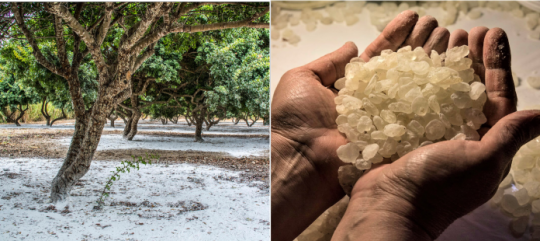
The mastiha tree is a trademark of Chios and the main source of income for many residents on the Greek island. Its cultivation started in ancient times as the trees produce a rare resin in the shape of teardrops, which is largely exported around the world.
But today, some old or abandoned mastiha trees on the island need a regeneration. This is where the new environmental project, ‘Adopt a Chios Mastiha tree,’ comes into the picture.
Launched in 2019 by Chios local, Lenia Ziglaki, the project aims to help Greek diaspora connect with the traditional process of mastiha cultivation, as well as ensure the future growth of the tree.
“The cultivation of Mastiha has been included by UNESCO in its list of the ‘Intangible Cultural Heritage of Humanity’,” the website reads.
5 notes
·
View notes
Photo

Garides (by Amuse * Bouche)
1 note
·
View note
Photo
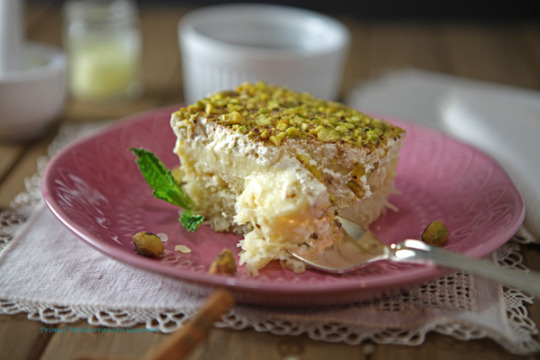
Greek Ekmek Kataifi (Shredded phyllo with syrup, custard and whipped cream) - It is so refreshing, light, and creamy… and no matter how ‘full’ you may feel there’s always room for a piece or two… This easy to follow ekmek kataifi recipe never fails to impress and is always a crowd pleaser.
#baking#dessert#greek#greek recipes#mediterranean#mediterranean recipes#kataifi#kadayıf#phyllo#mastiha#mastic#masticha#custard#ekmek#ekmek kataifi#ekmek kadayif
3 notes
·
View notes
Photo

L’isola di Chios e la sua “masticha”, un prodotto a denominazione di origine protetta - Link in bio! www.ramingare.com - #tourism #tourist #turismo #turismo2021 #turismolento #Grecia #grecia2021 #IsoleGreche #chios #chiosgreece #chiosisland #masticha #tradizioni #tradizionigreche #tradizionigrecia #prodotti #prodottigreci #prodottigrecia #estate2021 #pyrghì https://www.instagram.com/p/CNmcn2sjFwh/?igshid=47sc18mqvxem
#tourism#tourist#turismo#turismo2021#turismolento#grecia#grecia2021#isolegreche#chios#chiosgreece#chiosisland#masticha#tradizioni#tradizionigreche#tradizionigrecia#prodotti#prodottigreci#prodottigrecia#estate2021#pyrghì
0 notes
Photo
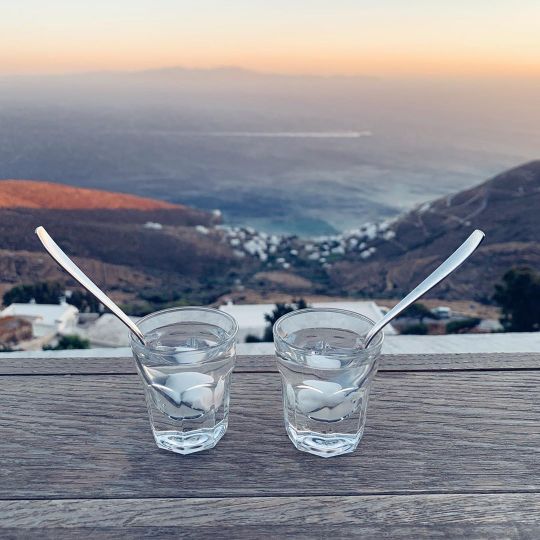
Submarines view [Aegean Sunsets] 🍧🌅 ~ 18.7.2020 #miniseries #triplets #aegean #aegeansunset #aegeansea #sunset #sea #aegeansea #view #aegeanview #desert #traditional #traditionalsweets #masticha #gourmet #travel #travelphotography #travelgreece #instadaily #instamoment #instamood #igers #igersgreece #greekislands #cyclades #tinos #greece #summer #summertime #summer2020 #summeringreece (at MAYOU All-day Bar) https://www.instagram.com/p/CCyqlxSpdgR/?igshid=tpi0swj80egg
#miniseries#triplets#aegean#aegeansunset#aegeansea#sunset#sea#view#aegeanview#desert#traditional#traditionalsweets#masticha#gourmet#travel#travelphotography#travelgreece#instadaily#instamoment#instamood#igers#igersgreece#greekislands#cyclades#tinos#greece#summer#summertime#summer2020#summeringreece
0 notes
Text
i miss masticha ice cream.....
1 note
·
View note
Text

Η #Ελλάδα 🇬🇷 είναι ο πρωινός Ελληνικός καφές ☕️ με ένα λουκούμι και η ζεστή κουβεντούλα με τους φίλους και με αγαπημένα πρόσωπα 🥰.
.
.
Δοκιμάστε μαζί με τον καφέ σας το ΜΟΝΑΔΙΚΟ λουκούμι με ΚΡΗΤΙΚΟ ΘΥΜΑΡΙΣΙΟ ΜΕΛΙ ΣΦΑΚΙΩΝ (στην φωτογραφία σε παραδοσιακή μαύρη συσκευασία) και με ευεργετική ΜΑΣΤΙΧΑ ΧΙΟΥ (σε λευκή συσκευασία).
.
📌Κάντε online παραγγελία από το σπίτι σας με ασφάλεια και ταχύτητα από το
https://www.mycretangoods.com/el-gr/product/2534818/Loukoumi-paradosiako-me-Sfakiano-thumarisio-meli/
Ακολουθήστε μας στις ΗΠΑ στο Instagram (www.instagram.com/cretanhoney_usa για ακόμη περισσότερα προϊόντα 👍🔝
.
.
#greece greekfood mastic masticha greeekdelight greekdelights honey cretanhoney#cretanhoney#thymehoney#honey#rawhoney#thyme#greekhoney#greece#sfakia#crete#anopoli
0 notes
Photo

Garides (by Amuse * Bouche)
0 notes
Text
Garides (by Amuse * Bouche)

0 notes
Link

I visited the Mastichochoria (villages involved in the production of mastic) on the island of Chios three times in order to witness the most important moments in the production of this precious good that keeps the locals, whose lives revolve around it, busy during the whole year.
The first visit was during the month of June, when people clear a circular area around every mastic tree and sprinkle limestone powder on the ground inside the cleared radius. They do this so that later, when the resin from the tree falls on this bare ground and solidifies, it’s easier to collect.
I went back in August for the most important phase, which requires knowledge and experience: Locals call it “kentima,” the Greek word for “embroidery.”
Early every morning, they would carefully carve the tree trunks with a sharp tool, the “kentitiri” (or embroidery stiletto), to draw out the resin without hurting the trees. As I watched, it struck me how significant the relationship is between these people and their trees. “Kentima needs respect,” they say, and that’s why these mastic producers always do the job themselves.
In September, I returned to the island. This is when people collect the mastic “tears,” crouching under the trees and making their way around on their knees. In an effort to take part, I tried the same and began to feel pain, but didn’t dare say anything, as crouching next to me was an uncomplaining 80-year-old who undoubtedly would be doing this for many days to come.
For the next phase, the women take charge, washing the resin tears with soap and water and jiggling them – like a baby, as they say – over sieves, and finally eliminating any leftover foreign bodies with a small knife, so the mastic is as pure as possible when it gets to the cooperative. This last step requires teamwork. It begins as soon as the resin is harvested and lasts virtually the whole winter. Women go from house to house, working together in groups.
See more from Clairy Moustafellou here:
http://moustafellou.gr/gallery/chios-mastiha/
2 notes
·
View notes
Text
Top 5 Benefits of Chewing Gum
History tells us that chewing gum has been a favorite pastime of people for thousands of years. In fact, the Greeks used to chew masticha, their version of the gum, made out of the resin from the mastic tree. The Mayans also made use of the sap of the sapodilla tree and made their own gum. But it was only in 1871 that a man named Thomas Adams patented a machine that produces the chewing gum we know today.
So why exactly do we chew gum, apart from the fact that it gives us something to do when we are bored? What benefits do we derive from chewing on gum? Here are 5 ways chewing gum can help you:
1. Chewing gum helps you manage your weight
A standard gum contains about 5 to 10 calories per serving. This is really low compared to other popular snack choices. Popping a piece of gum keeps you occupied and will thus stop you from eating food with higher calorie content. It suppresses your appetite, so that by the time you finish chewing, you will not be as hungry as you were before you opened a pack of gum.
2. It is a great stress reliever
Have you ever been stuck in heavy traffic? Have you ever experienced being in a ridiculously long line in a grocery store? Sometimes, in these situations, people get stressed simply because they are not doing anything except to wait for their turn. They begin to worry about the time they are wasting; they become very edgy and unable to keep still.
When you find yourself in a similar situation, chew a piece of gum and you will realize that you are chewing your worries away. This is because chewing is a physical activity where you are able to channel your frustrations.
3. It encourages you to focus
Often, athletes and soldiers are given gum to help improve their concentration and stay in the game. Also, various studies point out that gum improves memory. Those who continuously chewed gum throughout a battery of memory tests scored better than the non-gum eaters. This is why students are encouraged to chew gum whenever they are studying or taking their exams.
4. It is a great travel aid
Those who are not habitual plane travelers can find relief from ear irritation in the form of chewing gum. This is because the effects of changing air pressure are dampened by chewing gum. Also, a number of people say that chewing game reduces episodes of motion sickness.
5. It can be customized to suit various needs
Because chewing gum is a versatile product, it can made in such a way that it caters to the different needs of consumers. For instance, there are chewing gums with caffeine, so as to prevent drowsiness and give a jolt of energy to those who need it. There are also chewing gum substitutes for smoking, flavored with nicotine to help wean smokers from their nasty and self-destructive habit. Sugarless gum is also widely available, helping those with diabetes get their daily sweet fix without the guilt.
0 notes
Photo
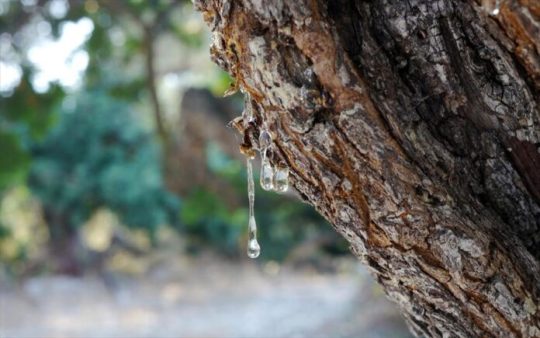
Τα δάκρυα του Αγίου Ισιδώρου και η μαστίχα Χίου Μαστίχα Χίου: Νεχώρι είναι ένα μαστιχοχώρι λίγα χιλιόμετρα από την πόλη της Χίου που κατά την παράδοση άφησε εκεί την τελευταία του πνοή, μετά από σκλ... Περισσότερα εδώ: https://www.elromio.gr/ta-dakrya-toy-agioy-isidoroy-kai-i-masticha-chioy/
0 notes
Photo

Wonderful masticha at (at Elaea Mezedadiko) https://www.instagram.com/p/B2KWAHKo1My/?igshid=19168imp11w6f
0 notes
Photo

New Post has been published on https://vacationsoup.com/tsoureki-bake-at-home-easter-bread/
Tsoureki bake at home Easter bread

Bread - it's the stuff of life!
Whilst the UK was last week celebrating Easter, Cypriots were still dealing with the hunger pains of Lent and getting ready for this weekend when they celebrate Easter according to the Greek Orthodox calendar. With that thought in mind it seems appropriate to discuss an Easter bread. We will leave Flaounes the glorious Cypriot recipe, used to create a celebratory cheese- and egg-stuffed pastry, for another day.
Today we will major on Tsoureki, a plaited Easter bread easily recognised by the red coloured eggs set on top of the loaf by bakers in Greece and Cyprus. The bread is flavoured by Masticha, small and very hard little pieces of resin known as tears of masticha. It adds a distinctive flavour akin to vanilla that's unlike anything you've tried before. The resin is gathered from the masticha tree and ground in a mortar and pestle with a little sugar to overcome the difficulty of effectively grinding them into powder.
The plaited Easter bread has a texture similar to brioche. It is delicious and goes well with a coffee or tea.
If you feel like having a go at making your own Tsoureki, here are the ingredients and the method:
Tsoureki Ingredients
(Makes 4 loaves of Tsoureki )
8 cups of strong flour
1/2 teaspoon salt
1 1/2 cups lukewarm milk
3 small packets of dry yeast
1 1/2 cup butter
1 1/2 cup sugar
zest of an orange and lemon
4 large eggs
1 egg beaten for brushing over the bread
4-5 tears of Masticha
Flaked Almonds and 8 red dyed hard boiled eggs for decoration
Method
Dissolve the active dried yeast in lukewarm milk with the sugar and 1 cup of the flour. Cover and leave for about 30mins until bubbly.
Melt butter in a saucepan over a low heat, add the orange and lemon zest and Masticha.
Take off heat and beat in eggs and leave to cool.
Mix the yeast mixture with above mixture and gradually add flour (with salt) and cover and leave for about 2 hours (until doubled in size).
Knock back dough on a floured board and cut into 4 pieces. Leave to stand for a few minutes and shape each piece into 3 sausage like shapes (about 10 – 12 inches long).
Secure them together at one end and then braid and secure at the other end.
Place the 4 Easter breads on a baking tray, cover and leave to rise for about 30 minutes.
Mix the remaining egg and lightly brush over the 4 pieces of bread. Sprinkle with flaked almonds and gently push two red eggs into each loaf.
Bake in a preheated oven for about 1 hour or until lightly golden and then sprinkle with sugar and leave to cool.
If it feels like too much work to create your own Easter bread, pay a visit to a Cypriot neighbour who will doubtless have some and will be thrilled to share with you. Whatever you do, don't miss the chance to join in what is the major celebration of the year on Cyprus. Yes, Easter is bigger here than Christmas!
Photo credit: Cyprus Tourist Guide
0 notes
Text
¡Hola!
My names is Chris, I am 18 years old from Greece. I’m mainly looking for a pen pal from Europe ( especially Spain). Recently I’ve started teaching myself Spanish on duolingo and I would love someone to help me or maybe learn Spanish together!!! I don’t really care about gender as long as you are near my age and friendly! Some of my favourite things are; water, tea, whales, food, naps, hugs, coffee and masticha!
P.S Shea Couleé was robbed ⚘⚘⚘
kallipygoi
9 notes
·
View notes